|
|
|
Sort Order |
|
|
|
Items / Page
|
|
|
|
|
|
|
| Srl | Item |
| 1 |
ID:
089967
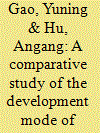

|
|
|
|
|
| Publication |
2009.
|
| Summary/Abstract |
The development of China's iron and steel industry (ISI) is an important indication of China's industrialization. This paper analyses the industry from the perspectives of historical retrospect, international comparison and sustainable development. We find that China's ISI has made huge progress at the technical level. During the same period of time its over-consumption of resources and impact on the environment has dropped. However, compared with other main developed steel producers, there is still a big gap. Besides, its openness is still much lower than those of other countries.
|
|
|
|
|
|
|
|
|
|
|
|
|
|
|
|
| 2 |
ID:
126247
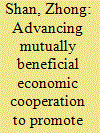

|
|
|
| 3 |
ID:
089969
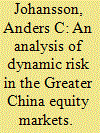

|
|
|
|
|
| Publication |
2009.
|
| Summary/Abstract |
This study looks at the time-varying nature of systematic risk in the Greater China equity markets. The Shanghai and Shenzhen markets both have a low average systematic risk when measured against the world market. The short outbursts in systematic risk for these two markets seem to be directly related to policy shifts. The Hong Kong and Taiwan markets are more integrated with world markets and they show signs of large variations in systematic risk over time. Furthermore, conditional betas in the Shanghai and Shenzhen markets are stationary, while the Hong Kong and Taiwan betas are integrated of order one. In addition, long memory tests show that all four markets exhibit a long-run dependence in their conditional betas. While the two mainland China market betas are covariance stationary, the Hong Kong and Taiwan betas are not.
|
|
|
|
|
|
|
|
|
|
|
|
|
|
|
|
| 4 |
ID:
025284
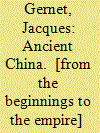

|
|
|
|
|
| Publication |
Berkeley, University of California Press, 1968.
|
| Description |
157p.Hbk
|
|
|
|
|
|
|
|
|
|
|
|
Copies: C:1/I:0,R:0,Q:0
Circulation
| Accession# | Call# | Current Location | Status | Policy | Location |
| 002831 | 931/GER 002831 | Main | On Shelf | General | |
|
|
|
|
| 5 |
ID:
127778
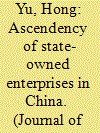

|
|
|
|
|
| Publication |
2014.
|
| Summary/Abstract |
The state sector still plays an important role in China's economy. One of the key development phenomena characterizing the Chinese economy is the rapid ascendency of state-owned enterprises (SOEs) and the resurgence of the state. The strength of China's SOEs is projected in the centrally administrated state-owned enterprises (CSOEs). They are the backbone of the national economy, spearheading national economic development and Beijing's 'going-out' strategy. The CSOEs have expanded their reach and increased their power, domestically and globally. In seeking to boost local GDP growth, the eastern provinces in China have joined the western provinces in a fierce contest to attract investment from SOEs. Nevertheless, the rapid ascendency of the SOEs has brought many negative consequences for China's economic, social and political development by causing conflict with the market-oriented development direction of Chinese economic reform and hindering fair competition between state-owned and non-state-owned enterprises.
|
|
|
|
|
|
|
|
|
|
|
|
|
|
|
|
| 6 |
ID:
130698
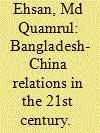

|
|
|
| 7 |
ID:
133191
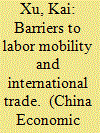

|
|
|
|
|
| Publication |
2014.
|
| Summary/Abstract |
This paper quantitatively evaluates the potential impacts of removing China's Hukou system on the world economy. By denying migrant workers the right to health benefits and housing, China's Household Registration (Hukou) system presents a significant distortion to the Chinese labor market that discourages the reallocation of its labor from agriculture to non-agriculture. I find that the elimination of Hukou could increase China's real income per capita by about 4.7%. Moreover, although for most countries the impact of removing Hukou is modest (less than 1% changes in real income per capita), substantial changes in real income could take place for China's small neighboring economies. For example, the decreases in real GDP per capita are 2.7%, 3.2%, and 4.1% for Bangladesh, Sri Lanka, and Vietnam, while Thailand stands to enjoy a 3.8% increase in its income.
|
|
|
|
|
|
|
|
|
|
|
|
|
|
|
|
| 8 |
ID:
146468
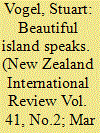

|
|
|
| 9 |
ID:
133453


|
|
Big question: how much confidence do you have in your nation's banking system?
/ Lee, Ann; Pelagidis, Theodore; Fourie, Leila; Marques, Fernando, Ocampo, Jose Antonio, Antonini, Massimo, Naik, Prithvi, Britto, Neil
|

|
|
|
|
| Publication |
2014.
|
| Summary/Abstract |
The global banking system is the fundamental conduit of value within nations and across borders. Since the last global financial crisis, however, the role of banks as a repository of value has come increasingly into question. Today, with a fragile recovery in so much of the world, banks and those who manage and regulate them are under attack. We asked our panel of global experts how this crisis of confidence is playing out in their nation or region.
|
|
|
|
|
|
|
|
|
|
|
|
|
|
|
|
| 10 |
ID:
117814
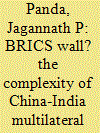

|
|
|
| 11 |
ID:
078023
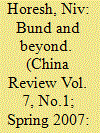

|
|
|
| 12 |
|
| 13 |
ID:
100690
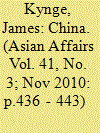

|
|
|
|
|
| Publication |
2010.
|
| Summary/Abstract |
The author suggests that the Chinese economy is no longer an export-driven economy but instead is driven by internal demand, which results from the rapid rate of growth over the last few years. The nearest comparison is with the development of a continental economy in the United States in the second half of the nineteenth century. But the Chinese economy is growing much more rapidly than the US at that time. Crucially, massive infrastructure development and workers' remittances back to the rural areas have transformed the economy of parts of China previously unmarked by development. As a result whole cities are growing up where not long ago there was nothing.
|
|
|
|
|
|
|
|
|
|
|
|
|
|
|
|
| 14 |
ID:
100255
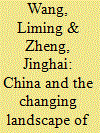

|
|
|
|
|
| Publication |
2010.
|
| Summary/Abstract |
The rapid development of emerging markets is changing the landscape of the world economy and may have profound implications for international relations. China is often regarded as the most influential emerging market economy because, during the last three decades, it has become increasingly integrated into the world economic system and its success and failure now affect the well-being of other nations in the world. As the financial crisis in the US and EU intensifies, the economic prosperity of the world depends to a large extent on the sustained development of the Chinese economy and other emerging markets, and vice versa.
|
|
|
|
|
|
|
|
|
|
|
|
|
|
|
|
| 15 |
ID:
102254
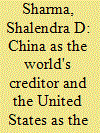

|
|
|
|
|
| Publication |
2010.
|
| Summary/Abstract |
China is now the world's leading creditor nation, while the United States is the world's largest debtor. Beijing is the largest foreign holder of US government debt - passing Japan in 2008 to become, in effect, the US government's largest foreign creditor. While some claim this gives Beijing unprecedented power over the United States, others claim that China's power is in fact greatly circumscribed. This paper shows that although current patterns of economic interdependence between the two economies invariably pushes each towards cooperation, China is deeply concerned about the future trajectory of the US economy and is already engaged in loosening the bonds of interdependence. This has profound implications for Sino-US relations and the global economy.
|
|
|
|
|
|
|
|
|
|
|
|
|
|
|
|
| 16 |
ID:
160384
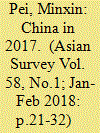

|
|
|
|
|
| Summary/Abstract |
Strongman rule returned to China in 2017 when Xi Jinping secured near-total political dominance. Repression remained intense while the Chinese economy performed reasonably well due to credit support. US–China relations are entering an uncertain phase. Strongman rule is likely to increase the risk of major policy mistakes and deliver few concrete achievements.
|
|
|
|
|
|
|
|
|
|
|
|
|
|
|
|
| 17 |
ID:
143179
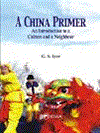

|
|
|
|
|
| Publication |
New Delhi, Vij Books India Pvt Ltd, 2016.
|
| Description |
xiii, 178p.hbk
|
| Standard Number |
9789385563249
|
|
|
|
|
|
|
|
|
|
|
|
Copies: C:1/I:0,R:0,Q:0
Circulation
| Accession# | Call# | Current Location | Status | Policy | Location |
| 058452 | 327.951/IYE 058452 | Main | On Shelf | General | |
|
|
|
|
| 18 |
ID:
143855
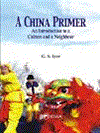

|
|
|
|
|
| Publication |
New Delhi, Vij Books India Pvt. Ltd., 2016.
|
| Description |
xiii, 178p.hbk
|
| Standard Number |
9789385563249
|
|
|
|
|
|
|
|
|
|
|
|
Copies: C:1/I:0,R:0,Q:0
Circulation
| Accession# | Call# | Current Location | Status | Policy | Location |
| 058490 | 327.951/IYE 058490 | Main | On Shelf | General | |
|
|
|
|
| 19 |
ID:
137526
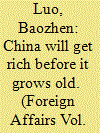

|
|
|
|
|
| Summary/Abstract |
At a conference on the Chinese economy in 2012, Cai Fang, a demographer at the Chinese Academy of Social Sciences, issued a dire warning: “There’s now no doubt China will be old before it is rich.” He was expressing a view widely held by economists and China watchers. Over the past 65 years, life expectancy in China has more than doubled, from 35 years to roughly 75, as the fertility rate has plunged. Many fear that if these trends continue, China’s population will age faster than the country can accommodate. In 2014, the share of China’s population older than 60 reached roughly 15 percent; demographers predict that figure will double by 2050, reaching the equivalent of nearly 450 million people, or about one-quarter of the world’s elderly
|
|
|
|
|
|
|
|
|
|
|
|
|
|
|
|
| 20 |
ID:
120840
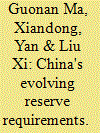

|
|
|
|
|
| Publication |
2013.
|
| Summary/Abstract |
We examine the role of reserve requirements as a cheaper substitute for the open market operations of the People's Bank of China (PBC) to sterilise foreign exchange interventions in recent years. China's reserve requirements have also been used to address a range of other policy objectives, not least macroeconomic management, financial stability and credit policy. The preference for reserve requirements reflects the size of sterilisation and the associated costs, in a quantity-oriented monetary policy framework faced with policy dilemmas. The PBC often finds it easier to make reserve requirement adjustments than interest rate decisions and enjoys greater discretion in applying this tool. The monetary effects of reserve requirements need to be explored not in isolation but in conjunction with other policy actions. Depending on the policy mix, higher reserve requirements tend to signal a tightening bias, to squeeze excess reserves of banks, to push market interest rates higher and to help widen net interest spreads, thus tightening domestic monetary conditions. Reserve requirements, however, impose an implicit tax burden on Chinese banks, albeit the latter seem to pass through a large but incomplete portion of these costs to their customers.
|
|
|
|
|
|
|
|
|
|
|
|
|
|
|
|
|
|
|
|
|